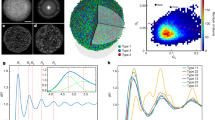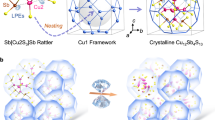Abstract
Amorphous materials are commonly understood to consist of random organizations of molecular-type structural units. However, it has long been known that structural organizations intermediate between discrete chemical bonds and periodic crystalline lattices are present even in liquids1,2. Numerous models—including random networks and crystalline-type structures with networks composed of clusters3,4 and voids5,6—have been proposed to account for this intermediate-range order7. Nevertheless, understanding and controlling structural features that determine intermediate-range order in amorphous materials remain fundamental, yet presently unresolved, issues7,8,9. The most characteristic signature of such order is the first peak in the total structure factor, referred to as the first sharp diffraction peak or ‘low Q’ structure. These features correspond to large real-space distances in the materials, and understanding their origin is key to unravelling details of intermediate-range order. Here we employ principles of crystal engineering to design specific patterns of intermediate-range order within amorphous zinc-chloride networks. Using crystalline models, we demonstrate the impact of various structural features on diffraction at low values of Q. Such amorphous network engineering is anticipated to provide the structure/property relationships necessary to tailor specific optical, electronic and mechanical properties.
This is a preview of subscription content, access via your institution
Access options
Subscribe to this journal
Receive 51 print issues and online access
$199.00 per year
only $3.90 per issue
Buy this article
- Purchase on Springer Link
- Instant access to full article PDF
Prices may be subject to local taxes which are calculated during checkout


Similar content being viewed by others
References
Debye, P. & Scherrer, P. Interferenzen an regellos orientierten teilchen im röntgenlicht. II. Nachr. Kgl, Gessel. Wiss., Göttingen, Math.-Phys Kl, 16–26 (1916)
Scherrer, P. Kolloidchemie (ed. Zsigmondy, R.)) 387–409 (Otto Spamer, Leipzig, 1920)
Červinka, L. Medium-range order in amorphous materials. J. Non-Cryst. Solids 106, 291–300 (1988)
Gladden, L. F. & Elliott, S. R. Computer-generated models of α-SiSe2. 2. structural studies. J. Non-Cryst. Solids 109, 223–236 (1989)
Elliott, S. R. The origin of the first sharp diffraction peak in the structure factor of covalent glasses and liquids. J. Phys. Condens. Matter 4, 7661–7678 (1992)
Wilson, M. & Madden, P. A. Voids, layers, and the first sharp diffraction peak in ZnCl2 . Phys. Rev. Lett. 80, 532–535 (1998)
Wright, A. C. Diffraction studies of glass structure: The first 70 years. Glass Phys. Chem. 24, 148–179 (1998)
Elliott, S. R. Medium-range structural order in covalent amorphous solids. Nature 354, 445–452 (1991)
Gaskell, P. H., Eckersley, M. C., Barnes, A. C. & Chieux, P. Medium-range order in the cation distribution of a calcium silicate glass. Nature 350, 675–677 (1991)
Martin, J. D. et al. Metal halide analogues of chalcogenides: A building block approach to the rational synthesis of solid-state materials. Chem. Mater. 10, 2699–2713 (1998)
Martin, J. D. & Greenwood, K. B. Halozeotypes: a new generation of zeolite-type materials. Angew. Chem. 36, 2072–2075 (1997)
Martin, J. D. & Thornton, T. A. in Liquid Crystal Materials and Devices (ed. Bunning, T. J.) Proc. Mat. Res. Soc. 559, 243 (1999).
Badyal, Y. S. & Howe, R. A. An isotopic substitution study of NiCl2-KCl and ZnCl2-KCl binary molten salt mixtures. J. Phys. Condens. Matter 8, 3733–3754 (1996)
Wasse, J. C. & Salmon, P. S. Structure of KCl-BiCl3 ionic glasses by neutron diffraction. J. Phys. Condens. Matter 10, 8139–8146 (1998)
Rousselot, C., Tachez, M., Malugani, J. P., Mercier, R. & Chieux, P. Characterization of intermediate-range order in superionic AgPO3-AgX (X = I, Br, Cl) glasses by neutron diffraction. Solid State Ion. 44, 151–158 (1991)
Lee, J. H. & Elliott, S. R. Isotopic-substitution neutron-diffraction studies of (AgI)0.5(AgPO3)0.5 glass. Phys. Rev. B 54, 12109–12114 (1996)
Desa, J. A. E., Wright, A. C., Wong, J. & Sinclair, R. N. A neutron-diffraction investigation of the structure of vitreous zinc-chloride. J. Non-Cryst. Solids 51, 57–86 (1982)
Biggin, S. & Enderby, J. The structure of molten zinc-chloride. J. Phys. C 14, 3129–3136 (1981)
Tachez, M., Mercier, R., Malugani, J. P. & Chieux, P. Structure determination of AgPO3 and (AgPO3)0.5(AgI)0.5 glasses by neutron diffraction and small angle neutron scattering. Solid State Ion. 25, 263–270 (1987)
Swenson, J. Medium-range order in permanently densified SiO2 and GeO2 glass. Phys. Rev. Lett. 79, 1421 (1997)
Teo, B.-K. & Calabrese, J. C. Stereochemical systematics of metal clusters. Crystallographic evidence for a new cubane-chair isomerism in tetameric triphenylphosphine silver iodide. Inorg. Chem. 15, 2474–2486 (1976)
Gaskell, P. H. Relationships between the medium-range structure of glasses and crystals. Mineral. Mag. 64, 425–434 (2000)
van der Lugt, W. Chemistry Structure and Bonding of Zintl Phases and Ions (ed. Kauzlarich, S. M.) 183–224 (VCH, New York, 1996)
Hirotsu, Y., Matsushita, M., Ohkubo, T., Makino, A. & Oikawa, T. Average and local structures of amorphous Pd75Si25 alloy analyzed by modern electron diffraction techniques. Mater. Sci. Eng. A 226–228, 274–279 (1997)
Egami, T. Universal criterion for metallic glass formation. Mater. Sci. Eng. A 226–228, 261–267 (1997)
Salmon, P. S. Real space manifestation of the first sharp diffraction peak in the structure factor of liquid and glassy materials. Proc. R. Soc. Lond. A 445, 351–365 (1994)
Acknowledgements
The assistance of GLAD-IPNS beamline scientists Y. Badyal and C. Benmore is gratefully acknowledged. This work was supported by the NSF, and the US DOE-BES Division of Materials Sciences. J. D. M. is a Cottrell Scholar of the Research Corporation.
Author information
Authors and Affiliations
Corresponding author
Ethics declarations
Competing interests
A US patent title “Templated Compositions of Inorganic Liquids and Glasses” has been filed by J.D.M. and North Carolina State University.
Supplementary information
Rights and permissions
About this article
Cite this article
Martin, J., Goettler, S., Fossé, N. et al. Designing intermediate-range order in amorphous materials. Nature 419, 381–384 (2002). https://doi.org/10.1038/nature01022
Received:
Accepted:
Issue Date:
DOI: https://doi.org/10.1038/nature01022
This article is cited by
-
A model evaluation of entropies and related thermal quantities of alkali halides based on a generalised bonding scheme
Indian Journal of Physics (2024)
-
A medium-range structure motif linking amorphous and crystalline states
Nature Materials (2021)
-
Distinctive Slow β Relaxation and Its Impact on Mechanical Property of LaCe Based Bulk Metallic Glasses
Metals and Materials International (2020)
-
Hidden polymorphs drive vitrification in B2O3
Nature Materials (2012)
-
Metallotropic liquid crystals formed by surfactant templating of molten metal halides
Nature Materials (2006)
Comments
By submitting a comment you agree to abide by our Terms and Community Guidelines. If you find something abusive or that does not comply with our terms or guidelines please flag it as inappropriate.



